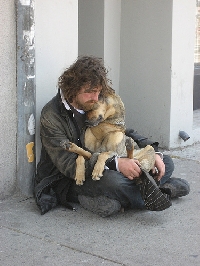
Putting a pet to sleep means ending its life through euthanasia
One of the biggest and hardest decisions that a pet owner ever has to make is whether or not to put his pet to sleep. Sometimes it?s necessary, even though the owner struggles with this decision. And no wonder. Pet owners love their pets, often nearly as much as they love their own children.
Losing a pet is extremely painful, particularly if that dog or cat or any animal has been an integral part of your family for a long time.
When a pet is put to sleep he is euthanized. Some vets think the time is when the bad days outnumber the good days. If your pet is very old, sick and suffering and doesn?t have much quality of life it may be time.
Observe your pet. Ask yourself these questions:
- Is she still eating?
- Is she still enjoying regular activities, such as walking or sitting on the couch in the evenings with her master?
- Doe she still enjoy interacting with humans and is she still aware of who you are?
- Can she move around without pain or difficulty?
- Is your pet soiling herself during the day?
If you answered yes to any of these questions, your dog’s state of health can be extremely stressful for an animal that prefers to be mobile and clean. She can also contract infections and rashes on her skin from sitting in feces and/or urine.
~
When a pet to is put to sleep or euthanized, he is generally given a sedative tranquilizer before getting the euthanasia drug, which is given in the vein. The owner can stay with the pet, spending some time alone with the pet and saying her goodbyes. Some owners stay through the entire process. However, if the owner is terribly upset the pet can sense this. It may be in the pet?s best interest to leave before the euthanasia is given.
The euthanasia makes the heart stop and it halts the breathing muscles because it is an overdose of barbiturates.
When the pet is in the process of dying, you may hear one last agonal breath or gasping breath, which is a muscle spasm. The pet?s eyes do not close. There may be muscle twitching and the animal may make some sounds, which is called vocalization.
It is possible that the dog will eliminate the contents of his bowels and urinary bladder. The animal?s heart may keep beating for a short period of time after his breathing has stopped.
Although the process may vary depending on the animal, usually what the owner observes is a release of tension from the animals? body and a peaceful passing. This is why it is called ?going to sleep.?
Anyone who has lost a pet either from natural causes, an accident or because the animal had to be put to sleep due to a serious disease or injury knows how incredibly painful the loss is. Pets are our buddies. We spend a lot of time with them. They are our companions and friends and know when and how to comfort us with a nuzzle of their nose against our leg.
If you are experiencing grief, you do not have to apologize for it. Ignore those people who dismiss your sadness. Apparently, they have not had the privilege of loving a pet so they don?t understand the depth of your loss.
In time, you will come to accept the loss of your pet but you still have memories and memories keep us going. Bury your pet in a special place and visit it occasionally. It helps to know that he is still nearby. Many people who have put their pet to sleep find comfort in pet memorial stones, a planted tree or making a donation to a favorite dog park.

